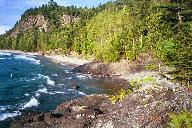| Credits:
Photographs for locations 3 and 4 were provided by Mike Hailstone, District
Geologist, Sault Ste. Marie Resident Geologist District, Ministry of Northern Development
and Mines, Ontario.
References:
Hamblin, W., 1958, Cambrian Sandstones of northern Michigan, Michigan
Department of Conservation, Geological Survey Division, Publication 51, 146 p.
Kalliokoski, J., 1982, Jacobsville Sandstone, in Geology and Tectonics of the Lake
Superior Basin, edited by R.J. Wold and W.J. Hinze, Geological Society of America, Memoir
156, pp 147-155.
Ojakangas R. W. and Morey, G.B., 1982, Keweenawan sedimentary rocks of the Lake
Superior Region: a summary, in Geology and Tectonics of the Lake Superior Basin, edited by
R.J. Wold and W.J. Hinze, Geological Society of America, Memoir 156, pp 157-164.
Van Schmus, W.R., Green, J.C., Halls, H.C., 1982, Geochronology of Keweenawan rocks
of the Lake Superior region: a summary, in Geology and Tectonics of the Lake Superior
Basin, edited by R.J. Wold and W.J. Hinze, Geological Society of America, Memoir 156, pp
165-171.
Halls, H.C. and Pesonen, L.J., 1982, Paleomagnetism of Keweenawan rocks, Geology
and Tectonics of the Lake Superior Basin, edited by R.J. Wold and W.J. Hinze, Geological
Society of America, Memoir 156, pp 173-201. |



